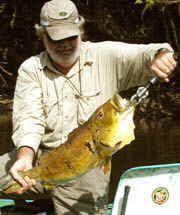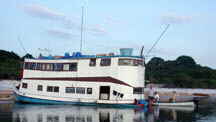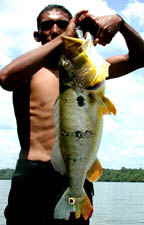 |
||||||||||||
|
|
||||||||||||
|
|
||||||||||||
|
|
||||||||||||
|
|
||||||||||||
|
|
||||||||||||
|
|
||||||||||||
|
|
||||||||||||
|
|
||||||||||||
|
|
||||||||||||
|
|
||||||||||||
 |
||||||||||||
 |
||||||||||||
|
|
||||||||||||
|
|
||||||||||||
 |
|
|
|
|
Exploring the Nhamunda by Larry Larsen
I fought the "fish" to the boat and quickly noticed that I did not have a peacock bass hooked. I had actually hooked two peacocks, one on either end of the Woodchopper. Greg Margerum and Bill Gager entered the same lagoon behind me and noticed my catch. They totaled ony five pounds, but made for an interesting start to the day. Greg and Bill moved to the opposite side of the lake and began casting. Within a couple of minutes, they were hollering. I had my guide motor over for a look. Greg had hooked a giant peacock which immediately dove into a tree. His guide had stripped down and dove in to capture the fish still attached to the hung-up plug. They held up the 13 ½ pound peacock for a couple of photos before releasing it. It was quite an exhilarating experience for all of us. Unfortunately, the fishing then slowed in that lake and the adjacent one. I moved to another lagoon and found two good fish. The first, a 12 pounder, blew up on my topwater worked about 30 feet offshore, and the second, one pushing 14 ½ pounds, fell for the same Woodchopper trolled about that distance from the shallow bank. I continued to work other similar waters with depths of five to eight feet that day and connected with another 3 big fish between 12 and 13 ½ pounds. The "double" and five others all over 12 pounds in about 5 hours of fishing made for an active day.
I had caught 4 nice peacocks, and our partner boat with Jerry and Chad Gosselink had taken about 5 from the tiny lake when Bill tossed his large minnow bait toward the overgrown shoreline. He set back on the rod and started winding in his lightweight catch. When the catch had been reeled about half way back to the boat, we both almost fell out as we realized his "catch" was a very poisonous, 4-foot long snake. Neither Bill nor I wanted anything to do with the snake, telling the guide to cut the line and let it have the plug. The snake was hooked about 8 inches back from its viper-shaped head, one that was trying to sink its fangs into anything it could reach. Still the guide wanted to save the plug and diligently controlled the snake with the paddle until he could grasp it just behind the head. He then freed the plug and tossed the worn out snake into the bushes far from the boat. The snake was one of the few I have ever seen in my many trips to the Amazon region. I'm not sure what kind it was but our guide confirmed that it was indeed very deadly!
The following day, I had a very unusual occurrence that I could not believe. I was trolling a big topwater plug about 30 feet off a heavily-wooded lagoon bank when a 12 pounder jumped on the lure and headed for the timber along the shore. It went airborne as I put pressure on the fish. The peacock jumped straight up 3 feet out of the water and slammed into a rotten, 5-inch diameter tree limb. The limb broke and both it and the big peacock came crashing back on the surface. I worked the fish to the boat, expecting it to be knocked out, but it was still very much a fighter. In fact, it didn't show any ill sign of its collision with the deadfall log as I quickly released it. Our group of 5 anglers was small, and that's a big advantage when you're after pressured peacock bass. The Nexus Explorer is a classic Amazon riverboat that is ideal for taking small fishing parties into remote areas of Brazil. The boat explores the Upper Nhamunda River and other tributaries in search of trophy-class peacocks and giant jungle catfish. It accommodates up to 6 anglers a week, allowing for a more personalized angling adventure by an excellent staff. That means only 3 18-foot long fishing boats will be fishing the area from the Nexus. In waters fairly close to villages, that can be important. On the Lower Nhamunda, there was quite a bit of evidence of netters and commercial fishing boats. To escape them, you have to motor far away either with the Nexus or with the wooden fishing boats. You have to work into difficult-to-reach waters or those protected by the village counsel chiefs or mayors. Nexus owner Reinaldo Jose Tonete has established relationships with some and has purchased rights to sport fish the lagoons under some locals' controls.
The Boynton Beach angler was really dejected. But he was also excited about having on and clearly seeing the largest fish he had ever had to the boat. We worked that immediate area hard for about 5 minutes and then noticed a large fish chasing bait against the shore on the opposite side of the lake mouth. Our guide motored us across the 100-yard wide expanse, and on my second cast, the same fish exploded on my Woodchopper. It dove into a large submerged tree on the bottom and immediately became entangled. I kept a taut line as the guide maneuvered to the deadfall. There was no tugging on the other end of my line, but our guide stripped to his undies and slid over the side. He freed my plug, which was hooked to the tree about six feet below the surface. The big peacock had earned its release, but without seeing it, we could only guess at its size. I'm confident that it was a fish in the "teens." Those two fish battles, within eight minutes of each other, really got Bill excited about landing a giant, and on the following day, he did put a giant aboard for photos. He captured a 15 pounder on his Woodchopper and was one of two extremely happy clients aboard the Nexus that evening. The other was Jerry of Miami and Oro Valley Arizona. He caught and released five peacocks including a 16 pound giant that was fooled on a large, plastic minnow bait. The prime fishing season on the Rio Nhamunda is October through March, but the water level can play havoc with the fishing and access to it. High water usually allows the peacocks to swim far back into the forest, while low water prevents the Nexus from covering a lot of water from its initial base in the town of Nhamunda. An 8-day itinerary, allowing for a day of travel coming and going will put you on the water 6 full days.
Unfortunately, the fishing boats have only 15 hp outboards on them, meaning a relatively slow run upstream to the prospective "bounty". On a couple of days, a few of our party took a 4-hour boat ride to previously unfished waters. Had the Nexus, with its modern navigation gear, made it upstream past the shallow spot, then the fishing rigs would have been very adequate for the much shorter runs to the lakes and lagoons of the upper Nhamunda. We would have had much longer to fish in generally better waters that were further away from the towns (and commercial fishermen) of Nhamunda and Faro City. Nhamunda is a poor Brazilian river town with a population of 7,000 people. With just a handful of paved streets and another handful of vehicles, bicycles are the primary means of transportation on land. On the river banks in front of the town are several hundred boats of varying sizes. Behind the town is one of the most beautiful paved landing strips that I've ever seen and an unfinished paved road between it and downtown. Why the road hasn't been finished is unknown, but air charters to this region land on a dirt runway at Faro City, which is adjacent the town of Nhamunda. For more information on peacock bass go to www.peacockbassassociation.com and check out our book store for special savings on 3 peacock bass books! |
|
|
|
|
|

 We fought off spider webs, clinging vines, sharp broken tree limbs and a few bugs as we slowly paddled
through the overgrown creek. The 20 minute expedition through the almost inaccessible creek led to an isolated blackwater lagoon. I was sure the short trip
was worth it when, on my second cast, my large topwater bait generated an explosive strike.
We fought off spider webs, clinging vines, sharp broken tree limbs and a few bugs as we slowly paddled
through the overgrown creek. The 20 minute expedition through the almost inaccessible creek led to an isolated blackwater lagoon. I was sure the short trip
was worth it when, on my second cast, my large topwater bait generated an explosive strike.  Sighting of toucans, numerous macaws and green parrots that week made the ambiance typically Amazon-enjoyable. We noted the beautiful blue morphos butterflies, the huge
"pato" ducks and other bird life, plus 9-foot long caiman and a herd of wild hogs, but the most unusual sighting was a catch by Bill while he was
fishing with me. We had motored through a mile-long creek for an hour, pushing and pulling the boat over logs and fallen trees to access perhaps the most beautiful lagoon off the Rio Nhamunda.
Sighting of toucans, numerous macaws and green parrots that week made the ambiance typically Amazon-enjoyable. We noted the beautiful blue morphos butterflies, the huge
"pato" ducks and other bird life, plus 9-foot long caiman and a herd of wild hogs, but the most unusual sighting was a catch by Bill while he was
fishing with me. We had motored through a mile-long creek for an hour, pushing and pulling the boat over logs and fallen trees to access perhaps the most beautiful lagoon off the Rio Nhamunda. On day five, Bill and I took a 3-hour ride to one such lake, Lago Matapea, where,
after speaking with the ranch owner who controlled the water, we each had on a big fish. Bill's blew up on a Woodchopper fished near the mouth of the lake. He battled it
for about five minutes and slowly worked it near the boat. We clearly saw the 15-pound plus peacock darting away from the boat when it saw us at the same time. As
I reached for my bogagrip, Bill pulled the tired fish to the surface. It turned on its side, simply opened its mouth, and the lure popped free.
On day five, Bill and I took a 3-hour ride to one such lake, Lago Matapea, where,
after speaking with the ranch owner who controlled the water, we each had on a big fish. Bill's blew up on a Woodchopper fished near the mouth of the lake. He battled it
for about five minutes and slowly worked it near the boat. We clearly saw the 15-pound plus peacock darting away from the boat when it saw us at the same time. As
I reached for my bogagrip, Bill pulled the tired fish to the surface. It turned on its side, simply opened its mouth, and the lure popped free.